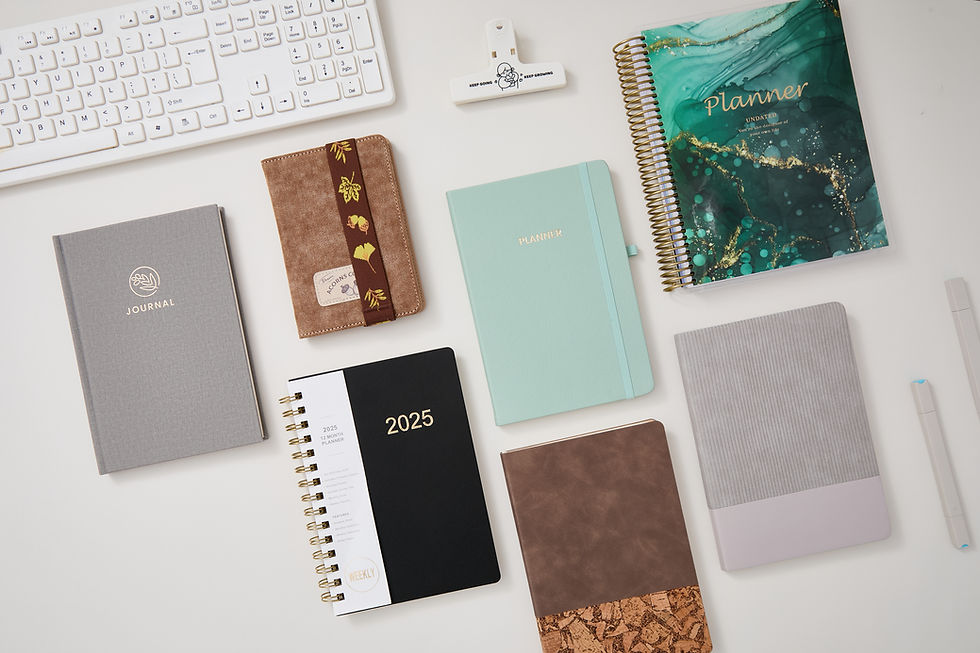A Complete Guide to Notebook Inner Page
- Lion Paper Team

- Jul 17
- 3 min read
Quick Content Reach:
Are you drowning in choices when selecting notebook inner page designs and materials? Worry no more! In this comprehensive guide, we will demystify everything—from paper types and layouts to longevity and writing experience—so you can confidently choose the best inner pages for your journal, planner, or notebook.

1. Notebook Cover is Different from Notebook Inner Page
1.1 Material
Notebook covers and inner pages serve distinct roles.
Covers are usually thicker—often coated or laminated—for durability and aesthetics.
In contrast, inner pages prioritize writing quality. Common materials include 70–120 gsm offset or woodfree paper, acid-free to prevent yellowing. Premium options like ivory-tone or fountain-pen friendly papers (e.g., Tomoe River-style) are gaining popularity.
1.2 Function
The core purpose differentiates them: covers protect inner content and define style, while inner pages are the functional canvas—facilitating smooth writing, note-taking, planning, or sketching.
In contrast, notebook cover can be much more functional and creative. Adding functional accessories, like pocket slot, pen loop, slow-rise sticker, or fluffy materials, to the cover could make the notebook popular and hot-selling.

2. Different Types of Inner Page
2.1 Lined
Widely used in journals, planners, and traditional notebooks. Line spacing ranges from college-ruled (7 mm) to wide-ruled (8.5 mm). Ideal for structured note-taking.
2.2 Blank
Perfect for artists, designers, or sketchers. No lines = creative freedom and visual openness.
2.3 Dotted
The flexible choice—light dotted grid provides subtle guides for bullet journaling, layout planning, or sketching. Dots are usually 5 mm apart.
2.4 Grid
Commonly 5 × 5 mm grid—favored by students and engineers for math, diagrams, or precise charts.
2.5 Customizable Option
For brand buyers, customizable inner pages allow integration of company logo, watermark, date layouts, habit trackers, planners, tabs, etc.

3. How to Select the Inner Page
3.1 Paper Quality and Longevity
GSM weight: 70–80 gsm suitable for most pens; fountain pens or ink markers require 90–120 gsm to prevent bleed-through.
Acid-free: Ensures longevity; ideal for keepsakes, archival notes.
Coating & sizing: Helps ink sit smoothly; coated papers are smoother but less absorbent.
3.2 Paper Size
Common sizes include A5 (148×210 mm), B5 (176×250 mm), or US Letter (8.5×11″). Consider notebook use case: portability vs. writing space.
3.3 Writing Experience
High-quality paper enhances comfort:
Smooth finish reduces pen drag
Resistance to feathering and bleed
Compatibility with pen type (gel, rollerball, fountain, marker)
4. Why Inner Page Matters
Differentiation & Brand Identity
Custom inner pages—branded layouts, dedicated content, unique designs—help your notebooks stand out.
User Engagement & Satisfaction
High-quality inner pages improve the reading & writing experience—driving repeat purchases.
Cost Efficiency in B2B Procurements
Bulk ordering of customized inner pages lowers unit cost and improves supply consistency.
Sustainability & Certification Compliance
Using certified, eco-friendly paper (e.g., FSC, PEFC, ISO9001) enhances corporate social responsibility image.
Conclusion
In the realm of notebooks, the inner page is more than paper—it’s the platform for ideas, organization, creativity, and brand expression. By considering material quality, layout design, and user needs, you can craft inner pages that truly add value and differentiate your brand.
If you're ready to elevate your notebook line with premium inner pages—customized layouts, eco-friendly certification, or luxury paper—Lion Paper Products is here to help.
Let’s collaborate to create stationery that resonates with your brand and delights your customers.
FAQs:
Q1: What is the best paper GSM for fountain pens?
A: 90–120 gsm is ideal to prevent bleed-through. For Tomoe‑River style ultra-smooth writing, even 68 gsm is possible.
Q2: Is acid-free paper necessary?
A: Yes—acid-free paper prevents yellowing, especially for keepsakes and archival records.
Q3: Can you print logos on inner pages?
A: Absolutely—watermark, header/footer, or full‑page branding are all options.
Q4: Can I choose paper color and texture?
A: Yes—options include ivory, cream, kraft, and premium textures like linen finish.
Q5: Do you test bleed-through and feathering?
A: Yes, our QA team tests each batch using various pen types.
Are you looking for a reliable manufacturer? Reach out to Lion Paper for a free quote and consultation. Let’s collaborate on creating custom writing paper products that will set your brand apart from the competition!





Comments